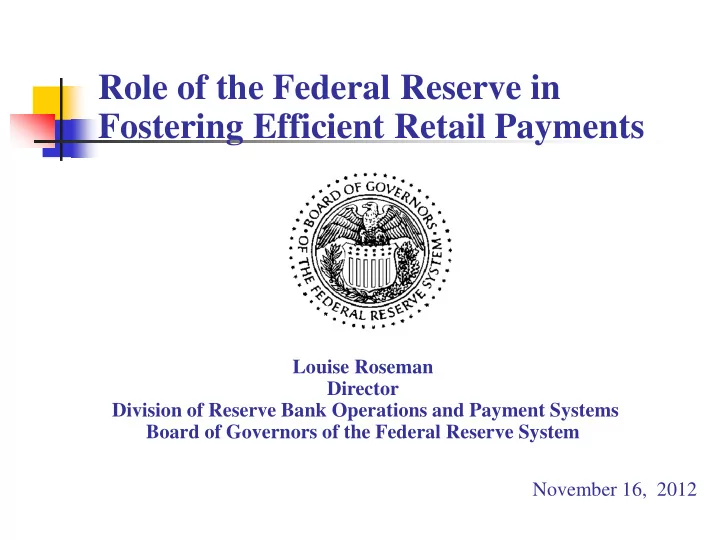

Role of the Federal Reserve in Fostering Efficient Retail Payments Louise Roseman Director Division of Reserve Bank Operations and Payment Systems Board of Governors of the Federal Reserve System November 16, 2012
Central banks can use various roles to foster an efficient retail payments Service provider Role influenced by history, legal/policy environment Balancing benefits of competition vs. economies of scale Regulator Catalyst for change Looking to the future 2
Central banks’ roles in providing retail payment services vary Although RTGS services are considered core central bank services, not all central banks provide retail payment services Federal Reserve retail payment services Check (roughly 35% market share) ACH (roughly 50% market share) 3
History can influence whether a central bank provides retail payment services Why does the Federal Reserve provide some retail payment services and not others? Services Fed provides Check (1910s): Was the primary wholesale payments system in the U.S. ACH (1970s): Leveraged check infrastructure; supported Treasury fiscal agent role Services Fed does not provide Card-based services: Concluded there was no need for central bank intervention; lack of synergies with other services 4
Central bank’s role as service provider may depend on its legal environment Does central bank have authority to provide retail payment services? If yes, are there any legal requirements that must be met? Federal Reserve Act does not restrict Fed’s authority to provide retail payment services Fed must price services to fully recover costs (Monetary Control Act of 1980) Must recover, over the long run, all actual costs (direct and indirect) and imputed costs and profit Fed publishes its fee schedule and cost recovery annually 5
Central banks should consider how to balance benefits of competition and economies of scale Key issue: Is market large enough to support multiple service providers? Central bank full-cost service pricing can foster competition, which – Promotes innovation in product offerings Provides incentive to control costs (but may deter investment in security and resiliency) Monopoly provider allows for greater economies of scale Fixed costs spread over greater volume But… may reduce innovation and lead to cost inefficiencies 6
Policy considerations may be relevant in a (potentially) competitive environment Federal Reserve criteria for entering new services Fed would be able to fully recover costs over the long run Fed entrance would provide a clear public benefit Other providers alone cannot be expected to provide the service with reasonable effectiveness, scope, and equity Competitive impact analysis required Would proposal have a direct and material adverse effect on the ability of other service providers to compete effectively with the Fed in providing similar services due to differing legal powers/constraints or a dominant market position of the Fed deriving from such legal differences? Objective: Provide a level playing field for private-sector competitors 7
Some central banks can use regulatory authority to foster efficiency Congress granted the Federal Reserve authority to regulate aspects of the interbank check system Fed has used this authority to improve efficiency Providing a faster, more efficient mechanism for returning unpaid checks Improved legal rights of correspondent banks so that they could better compete with the Fed in the provision of check services Fed also implements other, more specific, laws governing retail payments 8
Central banks can use their stature as a catalyst for payment system improvements The Federal Reserve has used its status as payments expert and objective party to promote payment system improvements Removing barriers to innovation Transition from paper-based to electronic check collection system (Check 21 – drafting statute; providing services) Industry processing improvements High-speed image capture for check processing Same-day ACH Standards for international ACH transactions Understanding payments system through research Triennial payments study 9
Central banks should continue to focus on retail payments efficiency in this quickly evolving market The Federal Reserve’s mission to foster the safety, efficiency, and accessibility of the U.S. payments system remains unchanged. Our future focus for retail payments will be to promote – Faster payments More efficient payments (especially B2B, P2P) More secure payments End-to-end , not just interbank Requires collaboration with payment services providers and end users. 10
Recommend
More recommend